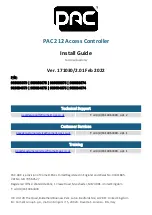
1-19
Cisco Wireless LAN Controller Configuration Guide
OL-9141-03
Chapter 1 Overview
Rogue Access Points
Figure 1-5
shows connections to the 4400 series controller.
Figure 1-5
Physical Network Connections to 4402 and 4404 Series Controllers
Rogue Access Points
Because they are inexpensive and readily available, employees sometimes plug unauthorized rogue
access points into existing LANs and build ad hoc wireless networks without IT department knowledge
or consent.
These rogue access points can be a serious breach of network security because they can be plugged into
a network port behind the corporate firewall. Because employees generally do not enable any security
settings on the rogue access point, it is easy for unauthorized users to use the access point to intercept
network traffic and hijack client sessions. Even more alarming, wireless users and war chalkers
frequently publish unsecure access point locations, increasing the odds of having the enterprise security
breached.
Rather than using a person with a scanner to manually detect rogue access point, the Cisco UWN
Solution automatically collects information on rogue access point detected by its managed access points,
by MAC and IP Address, and allows the system operator to locate, tag and monitor them. The operating
system can also be used to discourage rogue access point clients by sending them deauthenticate and
disassociate messages from one to four lightweight access points. Finally, the operating system can be
used to automatically discourage all clients attempting to authenticate with all rogue access point on the
enterprise subnet. Because this real-time detection is automated, it saves labor costs used for detecting
and monitoring rogue access point while vastly improving LAN security. Note that peer-to-peer, or
ad-hoc, clients can also be considered rogue access points.
Rogue Access Point Location, Tagging, and Containment
This built-in detection, tagging, monitoring, and containment capability allows system administrators to
take required actions:
•
Locate rogue access point as described in the
Cisco Wireless Control System Configuration Guide
.
•
Receive new rogue access point notifications, eliminating hallway scans.
•
Monitor unknown rogue access point until they are eliminated or acknowledged.
















































